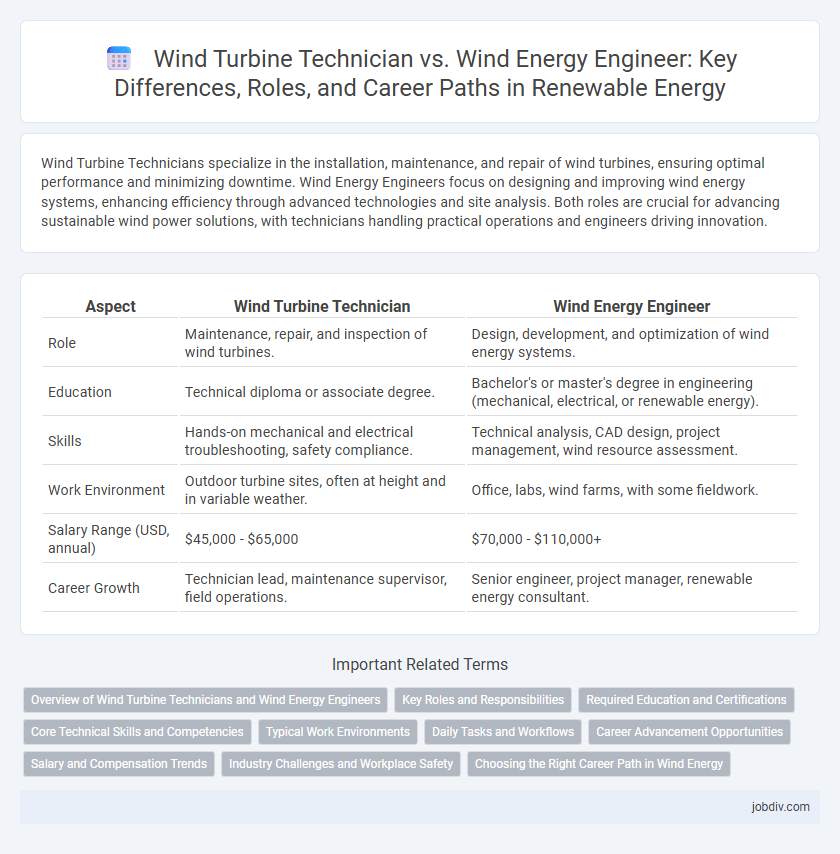Wind Turbine Technicians specialize in the installation, maintenance, and repair of wind turbines, ensuring optimal performance and minimizing downtime. Wind Energy Engineers focus on designing and improving wind energy systems, enhancing efficiency through advanced technologies and site analysis. Both roles are crucial for advancing sustainable wind power solutions, with technicians handling practical operations and engineers driving innovation.
Table of Comparison
| Aspect | Wind Turbine Technician | Wind Energy Engineer |
|---|---|---|
| Role | Maintenance, repair, and inspection of wind turbines. | Design, development, and optimization of wind energy systems. |
| Education | Technical diploma or associate degree. | Bachelor's or master's degree in engineering (mechanical, electrical, or renewable energy). |
| Skills | Hands-on mechanical and electrical troubleshooting, safety compliance. | Technical analysis, CAD design, project management, wind resource assessment. |
| Work Environment | Outdoor turbine sites, often at height and in variable weather. | Office, labs, wind farms, with some fieldwork. |
| Salary Range (USD, annual) | $45,000 - $65,000 | $70,000 - $110,000+ |
| Career Growth | Technician lead, maintenance supervisor, field operations. | Senior engineer, project manager, renewable energy consultant. |
Overview of Wind Turbine Technicians and Wind Energy Engineers
Wind Turbine Technicians specialize in the installation, maintenance, and repair of wind turbine components, ensuring optimal mechanical and electrical performance on-site. Wind Energy Engineers focus on designing, developing, and improving wind energy systems, analyzing wind resource data and turbine efficiency to enhance energy production. Both roles are critical in advancing wind power technology, with technicians handling practical operation and engineers driving innovation through technical expertise.
Key Roles and Responsibilities
Wind Turbine Technicians are responsible for the installation, maintenance, and repair of wind turbines, ensuring optimal operational performance and safety compliance. Wind Energy Engineers design and develop wind power systems, optimize turbine efficiency, and conduct feasibility assessments for wind projects. Both roles contribute to sustainable energy production but focus respectively on hands-on technical maintenance and system design innovation.
Required Education and Certifications
Wind Turbine Technicians typically require a postsecondary certificate or an associate degree in wind energy technology, emphasizing hands-on training and OSHA certifications for safety compliance. Wind Energy Engineers usually hold a bachelor's degree in mechanical, electrical, or environmental engineering, with professional engineering (PE) licensure often needed for advanced project design and management roles. Both roles benefit from industry-specific certifications such as the Global Wind Organisation (GWO) safety training, which enhances practical skills and job marketability.
Core Technical Skills and Competencies
Wind Turbine Technicians excel in hands-on skills such as mechanical maintenance, electrical systems troubleshooting, and blade repair, ensuring optimal operation of wind turbines. Wind Energy Engineers possess advanced competencies in aerodynamic modeling, structural analysis, and renewable energy system design, enabling them to develop and optimize wind farm projects. Both roles require proficiency in safety protocols and data analysis, but engineers focus more on innovation and system integration while technicians emphasize practical implementation and maintenance.
Typical Work Environments
Wind Turbine Technicians primarily work outdoors on wind farms, performing maintenance, inspections, and repairs on turbine components often at great heights. Wind Energy Engineers typically operate in office settings or research facilities, focusing on designing, testing, and improving wind energy systems with occasional site visits for project assessment. Both roles require collaboration with multidisciplinary teams to optimize wind energy production and ensure turbine reliability within diverse environmental conditions.
Daily Tasks and Workflows
Wind Turbine Technicians primarily focus on the installation, maintenance, and repair of wind turbines, conducting routine inspections, troubleshooting mechanical and electrical issues, and ensuring optimal turbine performance on-site. Wind Energy Engineers design and develop wind energy systems, analyze turbine efficiency, create project plans, and oversee large-scale operations with an emphasis on innovation, system optimization, and integration into power grids. Both roles require technical expertise but differ significantly in daily workflows, with technicians engaging in hands-on mechanical tasks and engineers focusing on analytical and design processes.
Career Advancement Opportunities
Wind Energy Engineers typically have broader career advancement opportunities due to their involvement in research, design, and project management, enabling transitions into leadership roles and specialized engineering positions. Wind Turbine Technicians advance by gaining experience, certifications, and moving into supervisory or maintenance management roles, which offers a more hands-on career path with increasing responsibilities. Both careers benefit from ongoing training in emerging technologies such as offshore wind systems and predictive maintenance analytics to enhance employability and promotion potential.
Salary and Compensation Trends
Wind Turbine Technicians typically earn median annual salaries ranging from $55,000 to $65,000, with opportunities for overtime and shift differentials enhancing total compensation. Wind Energy Engineers command higher salaries, often between $80,000 and $110,000 annually, reflecting advanced technical expertise and project management responsibilities. Compensation trends in the wind energy sector indicate steady growth, driven by increasing demand for renewable energy and advancements in turbine technology.
Industry Challenges and Workplace Safety
Wind Turbine Technicians face physical risks such as high-altitude work and exposure to harsh weather conditions, demanding rigorous safety protocols and continuous training to prevent accidents. Wind Energy Engineers encounter challenges in designing efficient, reliable systems that withstand environmental stressors while optimizing energy output, balancing innovation with stringent regulatory compliance. Both roles require ongoing adaptation to evolving technologies and industry standards to ensure workplace safety and sustainable energy production.
Choosing the Right Career Path in Wind Energy
Wind Turbine Technicians focus on installing, maintaining, and repairing wind turbines, requiring strong mechanical skills and on-site problem-solving abilities. Wind Energy Engineers design and develop wind energy systems, integrating advanced aerodynamics, electrical engineering, and environmental considerations for optimized performance. Choosing the right career path involves assessing preferences for hands-on technical work versus analytical design roles, as well as educational background and long-term career growth opportunities in the wind energy sector.
Wind Turbine Technician vs Wind Energy Engineer Infographic

 jobdiv.com
jobdiv.com